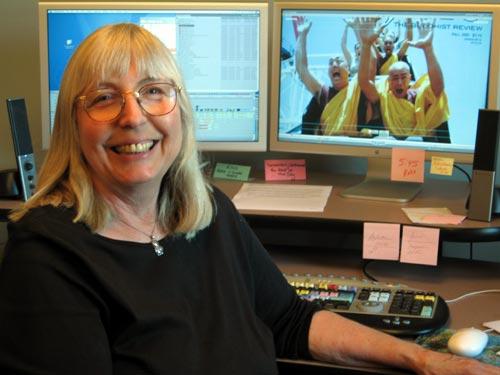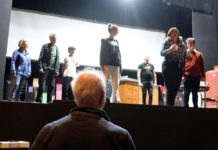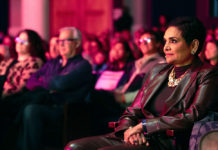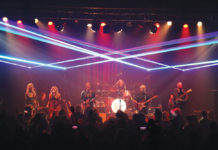Have you ever had to figure out the best way to feature a bowler
hat as a sensuous erotic toy, or decide how scenes of nude acrobats
walking on their hands should be edited? Or have you ever been
handed 400 hours of film, and asked to edit it down to a 90-minute
documentary? You can learn first hand how the world-class film
editor Vivien Hillgrove answered these artistic and professional
challenges (and how you can make your own movie better) at the
Sebastopol Center for the Arts on the evening of July 11th.
“I’ve had the joyful opportunity of working with some of the
finest movie directors and actors of all time,” Vivien says
modestly. “For example, I was supervising dialog editor on Milos
Forman’s “Amadeus,” and we had to record some of Salieri’s dialogue
again. I was concerned because the character aged so much over the
course of the movie, but as soon as F. Murray Abraham got in front
of the microphone he transformed before my eyes. For the first
scene, he was a youthful, creative young man—boldly pronouncing his
opinions as facts. Then, for the next scene, the gifted actor
melted into the worn-out body of an old man whose frail voice
evoked uncertainty and doubt. It was amazing to watch, and fun to
edit.”*
Other feature films Vivien has edited the dialogue on include
Francis Ford Coppola’s “One From the Heart,” David Lynch’s “Blue
Velvet,” Peter Weir’s “The Mosquito Coast,” Carrol Ballard’s “Never
Cry Wolf,” and Philip Kaufman’s “The Right Stuff.” She was picture
editor on Kaufman’s “The Unbearable Lightness of Being,” and “Henry
and June.”
Vivien relocated to Sonoma County nearly 20 years ago because:
“I wanted to live in a place where I could grow roots.” She also
made an artistic and aesthetic shift towards documentary film
editing. “Most often,” Vivien says, “a documentary doesn’t have a
script—it has a kernal or two of an idea and lots and lots of
film.” To illustrate her point, she gestures to a cork-covered wall
covered with slips of paper. This is the “storyboard” for a work in
progress— a documentary for which the director has shot over 400
hours of film. “My first task is just to get a handle on the
project,” Vivien says as she pulls three-ring binders from a nearby
bookshelf. “See? Here is all the footage featuring one particular
person. Here is another featuring a particular set of images—like
fields of grain or something similar and here,” she pauses as she
pulls out another binder, “here is an annotated list of all the
quotes the different filmed experts have to say about a particular
topic. These are all the little puzzle pieces, organized for me to
use as they are needed.”
And does all this organization and indexing and cross
referencing work? The proof is in the final product. Vivien has
edited six documentary films by Lourdes Portillo including “Corpus:
A Home Movie for Selena” and “Senorita Estravianda,” which won a
special jury prize at Sundance and the 2002 International
Documentary Award. Her other documentaries include “Yakoana, First
Person Plural” (POV), “Heart of the Sea” (Independent Lens) and
“The Future of Food,” advising the public on genetically modified
food. Her current projects include a POV documentaqry on
international adoption, and another on regenerative
agriculture.
But awards aside, the best testimony comes from the directors
who get to work with Vivien. For as director Anh Dudley Crutcher
once said: “We had been working on (“Yakoana”) for five years and
really focusing and concentrating and thinking about editing and
storyline and plot and tempo, and all of this stuff, and I had been
thinking about all of the little pieces, but really all I had been
doing was clearing a space in the forest. And, miraculously (when
the movie was finished), the indigenous people came and it was like
they had edited it. It was theirs. I really felt that. I couldn’t
see my fingerprints or Vivien’s fingerprints on it at all. And
that’s a large credit to her. She’s brilliant.”
Vivien Hillgrove will show clips from her films to illustrate
her editing secrets (and why they work), how music impacts a scene,
and the ease and delight of editing in this digital age. “Film
Editing: Putting the Puzzle Together,” is at 7:30 p.m., July 11th
at the Sebastopol Center for the Arts, 6780 Depot Street,
Sebastopol, CA 95472. For $15 tickets call (707) 829-4797 or email
li****@so***.net.
* F. Murray Abraham won the 1984 Academy Award for Best Actor,
and the sound editing team won another of the movie’s eight Oscars
for their work on “Amadeus.”
Comments? E-mail gi*********@co*****.net
53.5
F
Healdsburg
March 16, 2025








